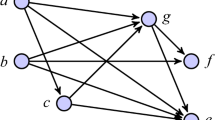Abstract
A key issue for high integration circuit design in the semiconductor industry are power constraints that stem from the need for heat removal and reliability or battery lifetime limitations. As the power consumption depends heavily on the capacitances between adjacent wires, determining the optimal ordering and spacing of parallel wires is an important issue in the design of low power chips. As it turns out, optimal wire spacing is a convex optimization problem, whereas the optimal wire ordering is combinatorial in nature, containing (a special class of) the Minimum Hamilton Path problem. While the latter is \({\mathcal{NP}}\)-hard in general, the present paper provides an \({\mathcal{O}{(N \log N)}}\) algorithm that solves the coupled ordering and spacing problem for N parallel wires to optimality.
Similar content being viewed by others
References
Burkard R.E.: Special cases of travelling salesman problems and heuristics. Acta Mathematicae Applicatae Sinica (English Series) 6(3), 273–288 (1990)
Burkard R.E., Çela E., Rote G., Woeginger G.J.: The quadratic assignment problem with a monotone anti-Monge and a symmetric Toeplitz matrix: easy and hard cases. Math. Program. 82, 125–158 (1998)
Burkard R.E., Deineko V.G., van Dal R., van der Veen J.A.A., Woeginger G.J.: Well-solvable special cases of the traveling salesman problem: a survey. SIAM Rev. 40(3), 496–546 (1998)
Coz Y.L.L., Iverson R.B.: A stochastic algorithm for high speed capacitance extraction in integrated circuits. Solid State Electron. 35, 1005–1012 (1992)
Gilmore P.C., Lawler E.L., Shmoys D.B.: Well-solved special cases. In: Lawler, E.L., Lenstra, J.K., Rinnooy Kan, A.H.G., Shmoys, D.B. (eds) The Traveling Salesman Problem, A Guided Tour of Combinatorial Optimization, chap. 4, pp. 87–143. Wiley, London (1985)
Groeneveld P.: Wire ordering for detailed routing. Des. Test Comput. 6, 6–17 (1989)
Macchiarulo, L., Macii, E., Poncino, M.: Low-energy encoding for deep-submicron address buses. In: Proceedings of the 2001 International Symposium on Low Power Electronics and Design, pp. 176–181 (2001)
Macchiarulo, L., Macii, E., Poncino, M.: Wire placement for crosstalk energy minimization in address buses. In: Proceedings of the Design, Automation and Test in Europe Conference and Exhibition, 2002, pp. 158–162 (2002)
Macii, E., Poncino, M., Salerno, S.: Combining wire swapping and spacing for low-power deep-submicron buses. In: Proceedings of the 13th ACM Great Lakes Symposium on VLSI, pp. 198–202 (2003)
Michaely S., Moiseev K., Kolodny A.: Optimal bus sizing in migration of processor design. IEEE Trans Circuits Syst Part 1 Regular Papers 53(5), 1089–1100 (2006)
Moiseev, K., Wimer, S., Kolodny, A.: Timing optimization of interconnect by simultaneous net-ordering, wire sizing and spacing. In: Proceedings of the IEEE International Symposium on Circuits and Systems, pp. 329–332 (2006)
Semiconductor Industry Association: International Technology Roadmap for Semiconductors (ITRS): 2005 Edition (2005). URL http://www.itrs.net/Links/2005ITRS/Home2005.htm
Supnick F.: Extreme Hamiltonian lines. Ann. Math. 66, 179–201 (1957)
Vygen J.: Near-optimum global routing with coupling, delay bounds, and power consumption. In: Bienstock, D., Nemhauser, G. (eds) Integer Programming and Combinatorial Optimization, Lecture Notes in Computer Science, vol. 3064, pp. 308–324. Springer, Heidelberg (2004)
Windschiegl A., Zuber P., Stechele W.: Exploiting metal layer characteristics for low-power routing. In: Hochet, B., Acosta, A.J., Bellido, M.J. (eds) Integrated Circuit Design, Power and Timing Modeling, Optimization and Simulation, Lecture Notes in Computer Science, vol. 2451, pp. 55–64. Springer, Heidelberg (2002)
Woeginger G.J.: Computational problems without computation. Nieuw Archief voor Wiskunde 5/4(2), 140–147 (2003)
Yim, J., Kyung, C.: Reducing cross-coupling among interconnect wires in deep-submicron datapath design. In: Proceedings of the 36th ACM/IEEE Conference on Design automation, pp. 485–490 (1999)
Zuber, P.: Wire topology optimisation for low power CMOS. Ph.D. thesis, TU München (2007). URL http://nbn-resolving.de/urn/resolver.pl?urn:nbn:de:bvb:91-dis s-20070802-618152-1-6
Zuber, P., Gritzmann, P., Ritter, M., Stechele, W.: The optimal wire order for low power CMOS. In: Integrated Circuit and System Design, Lecture Notes in Computer Science, vol. 3728, pp. 664–683. Springer, Heidelberg (2005)
Author information
Authors and Affiliations
Corresponding author
Additional information
Dedicated to Prof. Martin Grötschel on the occasion of his 60th birthday.
Rights and permissions
About this article
Cite this article
Gritzmann, P., Ritter, M. & Zuber, P. Optimal wire ordering and spacing in low power semiconductor design. Math. Program. 121, 201–220 (2010). https://doi.org/10.1007/s10107-008-0231-z
Received:
Accepted:
Published:
Issue Date:
DOI: https://doi.org/10.1007/s10107-008-0231-z




